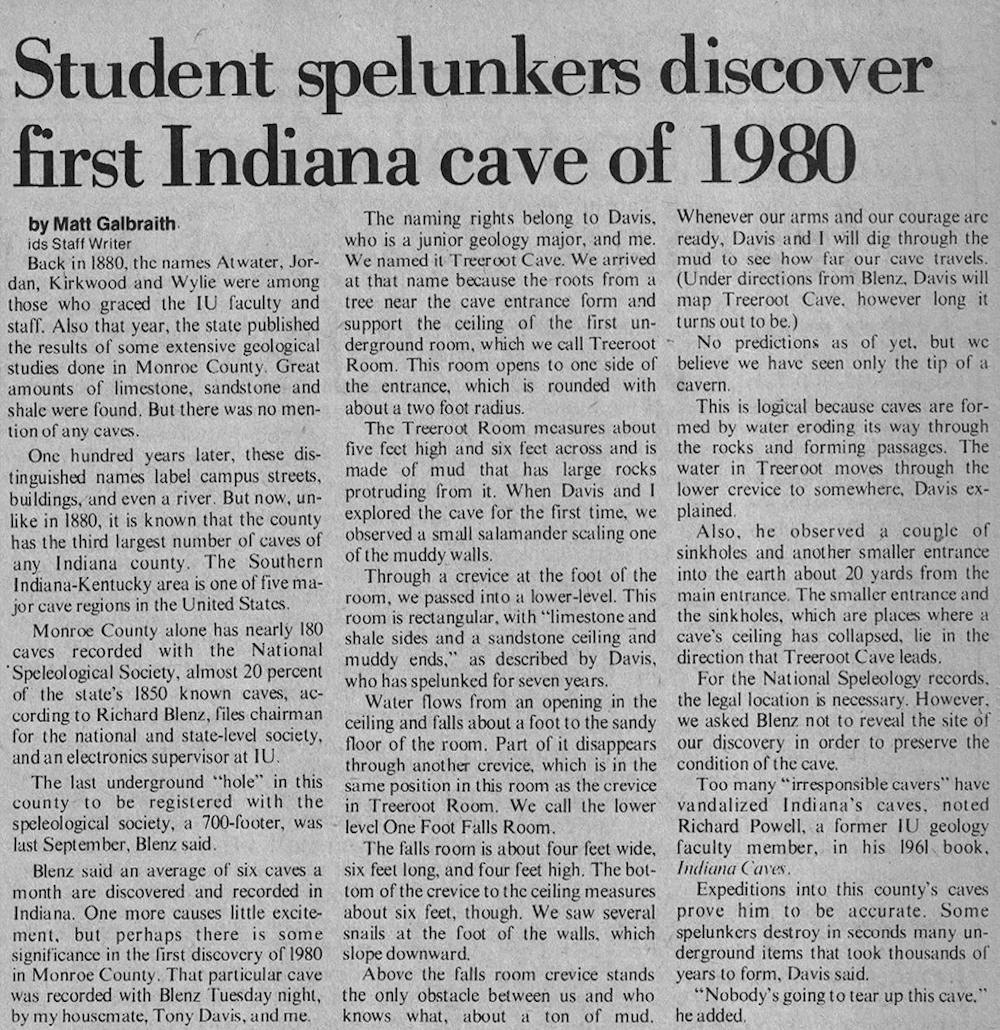Transcription: Student spelunkers discover first Indiana cave of 1980
By Matt Galbraith
Back in 1880, the names Atwater, Jordan, Kirkwood and Wylie were among those who graced the IU faculty and staff. Also that year, the state published the results of some extensive geological studies done in Monroe County. Great amounts of limestone, sandstone and shale were found. But there was no mention of any caves.
One hundred years later, these distinguished names label campus streets, buildings, and even a river. But now, unlike in 1880, it is known that the county has the third largest number of caves of any Indiana county. The Southern Indiana-Kentucky area is one of five major cave regions in the United States.
Monroe County alone has nearly 180 caves recorded with the National Speleological Society, almost 20 percent of the state’s 1850 known caves, according to Richard Blenz, files chairman for the national state-level society, and an electronics supervisor at IU.
The last underground “hole” in this county to be registered with the speleological society, a 700-footer, was last September, Blenz said.
Blenz said an average of six caves a month are discovered and recorded in Indiana. One more causes little excitement, but perhaps there is some significance in the first discovery of 1980 in Monroe County. That particular cave was recorded with Blenz Tuesday night, by my housemate, Tony Davis, and me.
The naming rights belong to Davis, who is junior geology major, and me. We named it Treeroot Cave. We arrived at that name because the roots from a tree near the cave entrance form and support the ceiling of the first underground room, which we call Treeroot Room. This room opens to one side of the entrance, which is rounded with about a two foot radius.
The Treeroot room measures about five feet high and six feet across and is made of mud that has large rocks protruding from it. When Davis and I explored the cave for the first time, we observed a small salamander scaling one of the muddy walls.
Through a crevice at the foot of the room, we passed into a lower-level. This room is rectangular, with “limestone and shale sides and a sandstone ceiling and muddy ends,” as described by Davis, who has spelunked for seven years.
Water flows from an opening in the ceiling and falls about a foot to the sandy floor of the room. Part of it disappears through another crevice, which is in the same position in this room as the crevice in Treeroot Room. We call the lower level One Foot Falls Room.
The falls room is about four feet wide, six feet long, and four feet high. The bottom of the crevice to the ceiling measures about six feet, though. We saw several snails at the foot of the walls, which slope downward.
Above the falls room crevice stands the only obstacle between us and who knows what, about a ton of mud. Whenever our arms and our courage are ready, Davis and I will dig through the mud to see how far our cave travels. (Under directions from Blenz, Davis will map Treeroot Cave, however long it turns out to be.)
No predictions as of yet, but we believe we have seen only the tip of a cavern.
This is logical because caves are formed by water eroding its way through the rocks and forming passages. The water in Treeroot moves through the lower crevice to somewhere, Davis explained.
Also, he observed a couple of sinkholes and another smaller entrance into the earth about 20 yards from the main entrance. The smaller entrance and sinkholes, which are places where a cave’s ceiling has collapsed, lie in the direction that Treeroot Cave leads.
For the National Speleology records, the legal location is necessary. However, we asked Blenz not to reveal the site of our discovery in order to preserve the condition of the cave.
Too many “irresponsible cavers” have vandalized Indiana’s caves, noted Richard Powell, a former IU geology faculty member, in his 1961 book, Indiana Caves.
Expeditions into this county’s caves prove him to be accurate. Some spelunkers destroy in seconds many underground items that took thousands of years to form, Davis said.
“Nobody’s going to tear up this cave,” he added.






